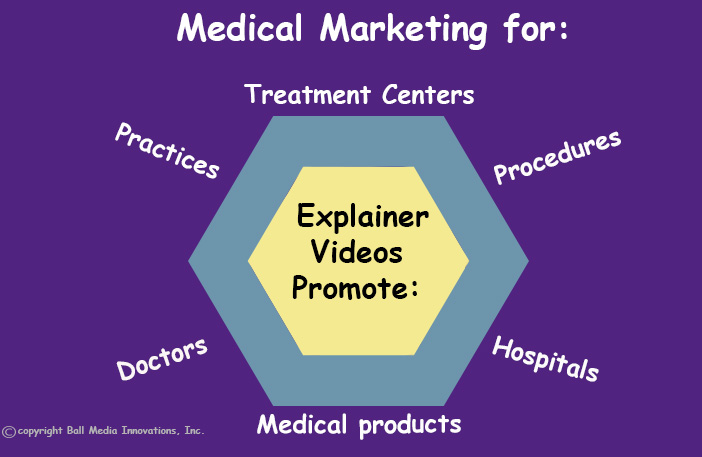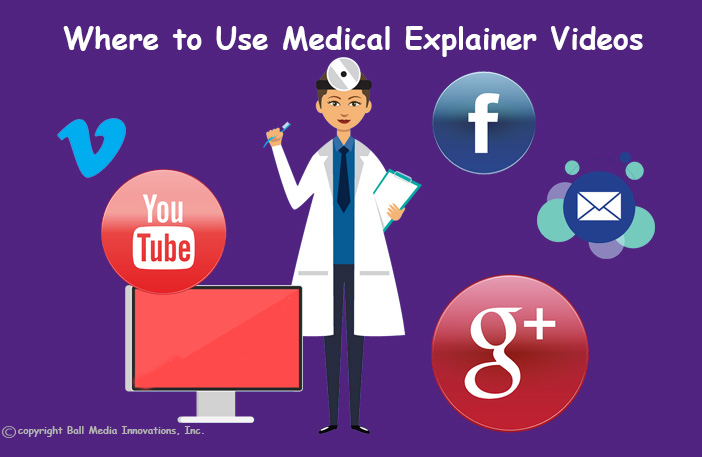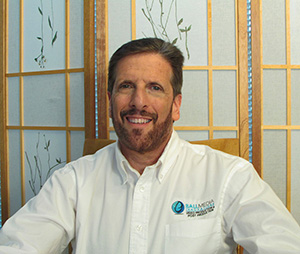By Greg Ball, President of Ball Media Innovations
If you haven’t considered using animated explainer videos for your medical marketing campaign, you’ll want to. What are explainer videos? You’ve probably seen them on various websites and on social media. Simply put, Explainer videos explain things. They usually teach about a product or service, or they can be used for training purposes.
Animated Explainer videos have been used by the medical community for some time.
They’re frequently used to explain things like:
- A specific condition
- Procedures and treatments
- Self-care procedures
They are also widely used for marketing purposes. Animated explainer videos can be effective for explaining exactly what makes a doctor, practice, hospital treatment center, procedure or product the right one for the patient.

What elements do you use when creating medical marketing animated explainer videos?
Though animated explainer videos are often completely 2-D animated, they can use a variety of other methods as well. This might include:
- Actors on screen.
- Doctors and/or patients on-screen.
- Video of locations, products, treatments, services, etc.
- 3-D animation
- Other forms of graphics.
Most explainer videos do use at least some animation, and many are completely animated. This can be highly effective at grabbing a viewer’s attention and keeping it. Animation can also be a great tool for explaining health issues in a way that’s visual, making it easier to understand.
You can also choose to use whiteboard animation. You've probably seen this. It's a form of animation where a hand is shown drawing on the screen, or writing words on the screen. This is extremely popular.
Why are animated explainer videos a great tool for medical marketing?
First, consider that in a recent poll of marketers, 83% of those who use home page explainer videos on their websites say that their videos are effective. And consider that the use of video itself is seen as a very effective marketing tool. In fact, 72% of businesses who use video believe that they increased their website conversion rates. (wyzowl)
When it comes to medical marketing, a well-designed animated explainer video can make emotionally difficult topics easier to handle. They can take a very heavy subject and lighten it up without making light of it.
They can also make technically difficult subjects easier to understand.
Here’s an example.
One of our medical clients developed a genetic test designed to determine the likelihood that an unborn baby might have Down Syndrome. This client wanted a video that would market the service in a responsible way. They needed a video that was designed to:
- Explain the meaning of the test.
- Explain the possible outcomes.
- Explain the test procedure.
- Explain the risks.
- Help women to decide whether to have the test or not.
This is a relatively complex subject and one that might be considered stressful. We needed to help the viewers make an educated decision. The client’s goal was to do this in a way that would help minimize their viewers’ anxiety.
To accomplish this, we designed an explainer video that used a combination of a live spokesperson, animation, words on the screen, and voice over.
The animation was perfect for explaining the meaning behind the testing of the genes and understanding chromosomes. It allowed us to help the viewer visualize something that can’t be seen with the human eye. The client specifically wanted explainer video-style 2-D animation for at least part of the video. She felt that this could lighten the emotional experience for their viewers.
The feedback the client received was excellent. The video has been successful. You can take a look at a portion of it here:
What is the lowest-cost way to produce animated explainer videos?
If you’re looking to keep your costs as low as possible, there are ways to cut costs. Explainer videos can be created on a relatively small budget. In the sample above, the use of a live actor increased the cost of the video significantly. This requires an actor, a studio, and a crew. It also increases editing costs. Leave that out and you’ve saved a lot of money. By sticking to all animation, the costs can be kept on the lower side.
Of course, you can add other elements to your explainer video without having to include a studio shoot. For example, for some projects, we’ve added stock footage and stock photos. It’s amazing what you can find out there. The use of pre-existing images and videos can significantly lower costs. We’ve also used photos taken by the clients.
Another benefit of using all animation and stock footage/photos is that in the time of COVID, these can be created without having exposure. These videos can be handled completely remotely.
Here's an example of a medical animation explainer video we created that uses only 2-D animation.
Using these videos in your marketing plan.
Getting them out to be seen by potential clients can also be done relatively inexpensively. They can be used:
- On the website you’re promoting.
- On YouTube and Vimeo.
- On social media sites such as Facebook, Linkedin, etc.
- On paid advertising throughout the web.
- In emails.
- In your office.

More about posting your explainer videos on Facebook.
This site has hundreds of thousands of groups focused on various health issues. If you’re able to locate Facebook groups that need the type of services you’re promoting, you might be able to get your video seen there at no cost to you.
Here are some tips for posting in these health-oriented Facebook groups.
First, you'll want to search out the groups that are relevant and join. Be sure to read the group rules before posting. Sticking to proper Facebook etiquette is important. If you disobey group rules you can be put out of the group and blocked from regaining entrance, ever.
Once you're accepted as a member, get involved with the group. Post your video once you've established a presence. Be sure to interact with other members and respond to your video or to your comments. You don't want to just drop video posts and leave. If you don't interact, it can look suspicious. It can make you look like you're in there only to promote your business or practice. That alone could get you banned.
Either way, explainer videos are widely thought of as a compelling and effective method for marketing.
More about putting your video on YouTube:
Even if you don't use YouTube now, it can be worthwhile to create your own channel for your video(s). YouTube is really the second largest search engine on the web. Potential clients might be searching for relevant videos on YouTube.
Another advantage to posting your video on YouTube is that it can help your website's ranking. Within your post, you can link to your website. Inbound links can be helpful for search engine optimization. You'll want to be sure to use appropriate keywords in your post. This means that you'll want to include keywords that your potential clients might use to search out a service or product like yours. This can help you get found.
Creating a YouTube channel is relatively easy. If it's not something you'd care to do, feel free to let us do that for you!
More about using paid advertising for your explainer video.
Explainer videos can be very eye-catching, which can be great for paid advertising. There are various sites that allow you to pay for web advertising such as Google Ads or Facebook Ads. These paid advertising forums allow you to target your audience and bid for ads.
However, you'll want to make sure that your explainer videos are not too long. 1-2 minutes is the length I'd recommend. Remember that web viewers tend to have short attention spans. You'll want to get your top sell points into the video within a short amount of time.
For doctor's offices: Showing your explainer video on in your office.
Many practices will play their explainer videos in their office waiting rooms. This is a great opportunity to show it to your clients. You might consider them a captive audience! These videos can be looped to replay or they can be added to other videos in order to retain the clients' attention. In this type of situation, you can create explainer videos that are a little bit longer.
If possible, add in some entertainment value, or use humor. Of course, this is not always appropriate, but if it is, it's a great strategy to hold the viewer's attention.
The other option is to show your explainer video to your client when they're placed in a private room. This might be especially appropriate when you're dealing with a sensitive subject. The best-case scenario is to share the video before the doctor visit. Then the doctor can come in and answer any questions the patient might have.
Medical animated explainer videos can also be used for training purposes.
Explainer videos are perfect for training patients. They can make very challenging topics easy to understand and apply. They're great for teaching them how to take care of themselves, and how to do at-home treatments.
Finally, for medical marketing, explainer videos must be well-planned to be effective.
Ultimately the purpose is to sell. To accomplish this, you'll want to handle this like any commercial. Check out our article called Creating Explainer Videos that Convert to Sales.
Do you need an animated explainer video for your medical practice or company? It's one of our specialties! There are two ways to contact us.
You can give us a call now. We'd be happy to chat and to give you a free estimate.
(954) 432-1274 (Miami - Fort Lauderdale)
(407) 205-0423 (Orlando)
(866) 570-8612 (Toll-Free)
Or Use the Contact Form Below (we'll keep your info private)
 ABOUT THE AUTHOR: Greg Ball is the founder and President of Ball Media Innovations, a full-service Miami video production company. One of their main specialties is video for the medical community. His company also offers national service for explainer videos, video/film translation (dubbing and subtitles), video editing, and video studio design and building. Ball Media Innovations also specializes in video production for training, marketing, social media, websites, conventions, conferences, and tradeshows. Prior to starting this company, Greg was the Manager of Worldwide Video Communications for Burger King World Headquarters.
ABOUT THE AUTHOR: Greg Ball is the founder and President of Ball Media Innovations, a full-service Miami video production company. One of their main specialties is video for the medical community. His company also offers national service for explainer videos, video/film translation (dubbing and subtitles), video editing, and video studio design and building. Ball Media Innovations also specializes in video production for training, marketing, social media, websites, conventions, conferences, and tradeshows. Prior to starting this company, Greg was the Manager of Worldwide Video Communications for Burger King World Headquarters.
©Copyright 2021. All rights reserved.
